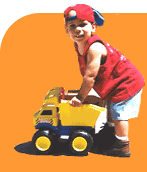Our baby boy is a late talker. I don't want anybody putting a label on him, but suffice to say, he has chosen to express himself verbally later than the average bear.
I began signing with him when he was eight or nine months old. The first sign I used was for 'don't do that' which was with palm down, waving the hand back and forth. At first I'd sign directly in front of the thing I didn't want him to do, then I'd remove him from that place (or distract him). After about a month, we progressed to a point where he would stop what he was doing when he saw the hand sign, or at the very least I could see him think about stopping! Consistency is the key and sometimes I wondered if the signing business was going to work at all. Then one day he used the sign himself.
I knew he was afraid of electrical noises and the vacuum cleaner scared him something terrible. I needed to clean our hard drive and I figured that the mini-vac was so small that it wouldn't scare him. I was wrong. As soon as I turned it on he became very distressed and started frantically waving his hand back and forth. I stopped immediately but it wasn't until a few minutes later that it dawned on me that he was using our sign language for don't do that! He was eleven months old.
Now he's 28 months old and I still use it occasionally. It reinforces the words, and I'm not sure why, but even when the words aren't working, the signs do and it has the added benefit that we can sign from across the room rather than holler!
If anyone tries to tell you that the use of sign language with your baby will impede or delay speech development, rest assured they don't know what they're talking about. Sign language exercises the mind. I read a paper about how in deaf people sign language uses the same area in the human brain as spoken language does. Babies have so much going on in their minds and their receptive language is way, way ahead of their ability to express themselves in words. For children who speak later than their peers, sign language is a godsend. Toddlers who can't convey their needs because they aren't talking are prone to having more temper tantrums and who wouldn't? I'd get mad too if I couldn't ask for food or drink or whatever I needed.
The signs we use most are for "help me," "thank-you," "please," "eat," "more," and "I hear something." The book that first turned me on the the idea of baby sign language is called Baby Signs:How To Talk With Your Baby Before Your Baby Can Talk by Linda Acredolo and Susan Goodwyn. I should emphasize that book even encourages you to make up your own signs and its purpose is to help your baby communicate, not to learn American Sign Language. After all, learning to speak ASL fluently is like learning any other language. It takes years. If your child does like ours, he will customize the hand signs as you introduce them anyway. I also purchased a book called Sign Language Made Simple by Karen B. Lewis and Roxanne Henderson which has good pictures and commonly used words and it's easy to look words up in.
As for web resources, there is a fantastic site created by Michigan State University called:
 American Sign Language Browser
that uses Quicktime and shows you how to sign thousands of words in ASL.
American Sign Language Browser
that uses Quicktime and shows you how to sign thousands of words in ASL.
Home | Unpreschooling | Resources for twos | Stuff to do age two
Skills lists | Curricula we've used | Suzuki violin | Journal
Mindful mothering | Homegrown kids | About the author
Email me|

